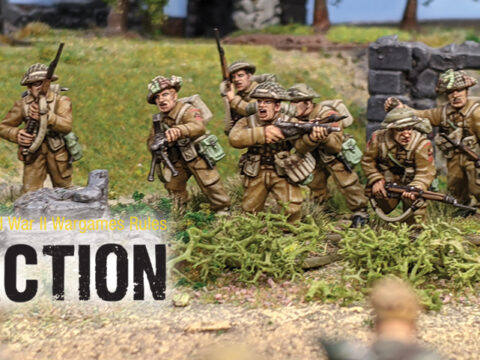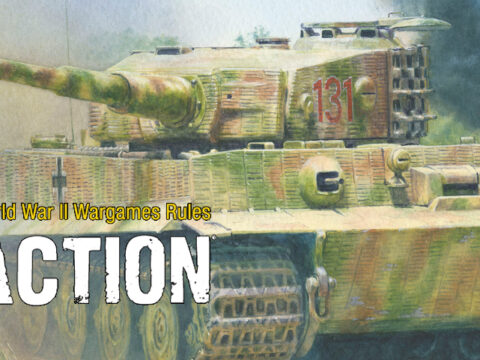Background
On October 1808 Sir John Moore took command of the Anglo-Portuguese army. He boldly led his 23,000 men into Spain, but a month later had to retreat rapidly, pursued by the enemy. His strategic position was not good, his Spanish allies had been defeated and had proved to be untrustworthy, and he faced a French force of approximately 200,000 men commanded by Napoleon himself. An intelligence intercept allowed him to threaten an isolated French force at Saldana; but learning that Napoleon was aware of his intentions, he began the epic retreat to the port of Corunna. In January 1809 Moore turned and engaged the chasing French, extricating his army, but at the cost of his own life. Sir John was a real warrior of Albion, so this was a great loss to both the British Army and the allied cause.
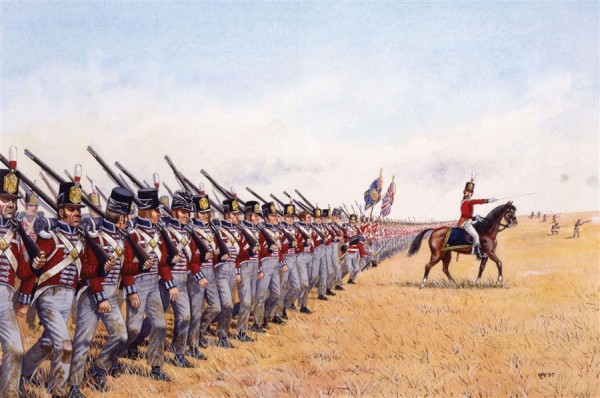
Courtesy of Osprey Publishing
With the British ejected, the French overwhelmed Portugal, their grip on the country only hampered by logistical difficulties. On the 22nd of April 1809, the British returned with Wellesley landing in command of an Anglo-Portuguese army. During May, the allies executed a brilliant campaign forcing the French under Marshal Soult to abandon Oporto with the loss of their artillery and baggage. By the start of July, Wellesley had moved into Spain and made contact with the 33,000 strong Spanish army under Cuesta by the 20th; both armies then manoeuvred to force Marshal Claude Victor’s 1st Corps away from menacing the Portuguese border. Victor duly fell back and retreated first to Almaraz and then to Talavera. Wellington now believed that he had a real chance of capturing the Spanish capital, Madrid, before the French armies could converge on him.
The Allies made contact with Marshal Victor near the city of Talavera on the 23rd of July, but missed a chance to maul him when the Spanish refused to fight, as it was Sunday, allowing Victor to withdraw. Cuesta chose to pursue, whilst Wellesley remained at Talavera de la Reina, approximately 75 miles south west of the Spanish capital. Cuesta’s pursuit stumbled to a halt when he caught up with Victor, who was now reinforced by General Sebastiani’s 4th Corps and by King Joseph’s Royal reserve at Torrijos. Outnumbered, the Spanish turned and rejoined the British, now pursued in turn by the French. The allied chance to capture Madrid had gone.
On arrival at Talavera, the Spanish were offered the right wing position (around Talavera itself) by Wellesley, who was dubious as to whether the Spanish would stand in the open. Talavera was surrounded by olive groves and stone walls, which made it into a formidable defensive position. The Spanish that were not deployed in Talavera also took up strong positions along a sunken road protected by more stone walls. The British took the Allied left, and deployed along a low ridge and a hill known as the Cerro de Medellin. To reinforce the centre of the line they built a redoubt at Pajar de Vergara.
Wellesley intended to do what he and is soldiers did best, fight a defensive battle. He was satisfied with his own forces’ situation, defending high ground where he could protect them from the worst of the French fire. He also hoped his Spanish allies would stand in their shielded positions. On the British front, the 1st Division held the Medellin, with the 2nd Division to its left; the 4th Division supported the redoubt. In the second line, Fane’s and Cotton’s cavalry were in reserve whilst the Spanish crossing points at the Alberche river were protected by the 3rd Division.
The French, recognising the strength of the Spanish positions, deployed the majority of their 46,000 troops against Wellesley, intending to defeat the British first and then move against the Spanish. Victor’s I Corps deployed on the French right facing the British and Portuguese, while Sebastiani’s Corps held the centre. On the left, Milhaud’s horsemen faced almost the entire Spanish army. Opposite the Medellin, 30 French cannon were situated on the Cerro de Cascajal, while Latour-Maubourg and the Madrid garrison remained in reserve. Formidable!
The Battle
The battle of Talavera began on the afternoon of the 27th July and started badly for the Allies with the initial action taking place at the Casa de Salinas, a ruined house about a mile west of the Alberche river. Prior to the arrival of the Spanish, Sherbrooke’s and Mackenzie’s divisions had been posted on the east bank of the river to protect the river crossing for the Spanish. Cuesta’s army arrived on the evening of the 26th, but did not cross the river until the 27th. The British then withdrew once the Spanish were safe across the Alberche. Mackenzie was ordered to act as a rearguard during these manoeuvres, whilst Wellesley used the Casa de Salinas to keep an eye on proceedings. Despite pickets having been posted, Lapisse’s division of Victor’s 1st Corps was able to cross the Alberche undetected and surprise Mackenzie. Three battalions were routed, 500 men lost and Wellesley nearly captured. The situation was steadied by the actions of the 45th Nottinghamshire and riflemen of the 60th Royal Americans, allowing Wellesley to rally the fugitives. The British were able to extricate themselves without further interference, despite the harassing fire of French horse artillery.
On the night of July 27th, Victor sent Ruffin’s Division to seize the Cerro de Medellin. Limited visibility saw two of Ruffin’s three regiments getting lost in the dark, but the 9th Leger still routed Sigismund Lowe’s exposed brigade and stormed the Medellin. This came about as Hill’s Division, which should have been on the crest of the Medellin, was actually camped a half mile away. The British managed to contain the situation and the French attack was eventually countered by Stewart’s Brigade.
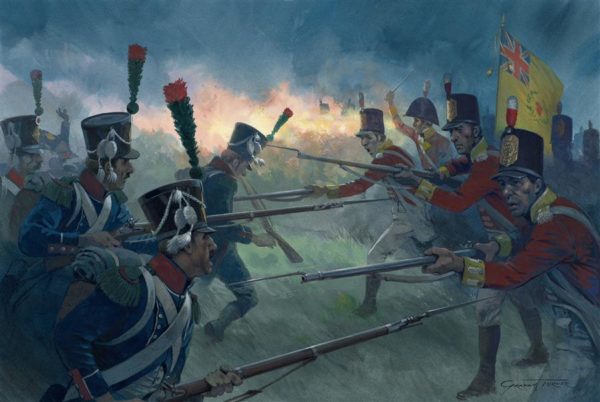
Battle for the Cerro de Medellin courtesy of Osprey Publishing
On the same evening, French dragoons were sent to probe the Spanish lines. Well before the French were in range, the entire Spanish line fired a volley at the horsemen. This event precipitated four Spanish battalions to throw down their arms and flee in panic, seemingly frightened by the sound of their own weapons. Just less than 2,000 Spanish fled the field, looting the British baggage train on the way.
The following morning saw no change in Victor’s plan. He was convinced that he could capture the Cerro de Medellin without support from the rest of the army. This was the first time Victor had fought against the British and he did not expect them to stand against his columns. Once again, Ruffin’s 5,000 men were selected for the Medellin assault following an artillery bombardment. The French came on in attack columns covered by skirmishers, each regiment’s three battalions advancing side-by-side. When Ruffin’s Brigade got within effective musket range, Tilson’s and Stewart’s Brigades, supported by Sherbrooke’s Brigade, emerged from cover in the now standard British two-deep line. Their volley fire halted the rattled French columns, which attempted to form line and return fire. To the cheers of the British, the French soon broke and fled as Sherbrooke proceeded to enfilade them. The fleeing French were pursued from the Cerro de Medellin by Stewart’s Brigade, the British ending their pursuit at the portina and then retiring back to their lines.
This phase of the battle had cost the French nearly 1,500 casualties. Hill’s Brigade, the most heavily engaged British formation, lost 750 men, with Hill himself receiving a head wound.
The defeat of Ruffin’s Division heralded a meeting of the French command: Victor, Sebastiani, Joseph and his chief of staff, Jourdan. The latter two favoured a defensive action; they knew that Marshal Soult was marching with 30,000 men to threaten the Allied rear which would force their retreat. Meanwhile, Victor argued for an all out attack on the Allied left and centre. The argument was ended when news reached the French that a Spanish force under General Venegas was moving to take Madrid; at the same time the generals discovered that Soult was delayed and would not now be able to threaten the Allied rear. The French could not allow the politically symbolic capital to fall to the Spanish, and would need to free formations from this encounter to fend them off. A full-scale assault was ordered against the British line.
The Divisions of Lapisse and Sebastiani and Leval’s Germans were selected for the task of driving Cuesta’s and Wellesley’s combined armies away. Lapisse’s Division was to attack the Cerro de Meddelin, followed by Leval’s Division, which was to attack the point in the line where the British and Spanish forces met. Finally Sebastiani was to attack the Guard’s Brigade and part of Cameron’s Brigade in the allied centre. Leval was to send his troops forward after Lapisse’s attack was delivered; but as Leval’s forces moved to their starting positions through rough terrain, they soon lost contact with the rest of the French army. Leval, believing his approach march had taken too long sent his forces forward to the attack – but he was too early. The rough terrain, mainly made up of olive groves, disordered his columns and they emerged from the terrain facing the Spanish left, British right and a gun battery on the Pajar de Vergara.
The deadly fire from the artillery redoubt smashed into the French columns before it and quickly dispersed them. Leval enjoyed some success, but was eventually driven off by the brigades of Campbell and Kemmis, losing 700 men and six guns.
The Divisions of Lapisse and Sebastiani attacked next. The French battalion columns came on in two separate and distinct attack waves made up of twenty four battalions, pitched at the eight battalions of Sherbrooke’s 1st Division. The French advance made good time until they moved into effective musket range. The British regiments opened fire simultaneously, and once again the French were checked by the effect of the British volleys. The front echelon soon broke and fled, and with hearty cheers the British charged forward to complete their discomfort. Some British battalions, including the Guards, got out of hand and pursued too far and were in turn checked by artillery and musketry from the second wave of French troops. This caused heavy casualties and the British retired in confusion.
This precipitate movement had made a hole in the British line, which Lapisse now moved to exploit. In all his battles, Wellesley showed an uncanny ability to be in the right place at the right time when a crisis loomed. This situation at Talavera was no exception and he personally ordered the 48th Northamptonshire Regiment to plug the gap, to be quickly reinforced with Mackenzie’s Brigade. The next stage of this clash now saw 3,000 British face 8,000 Frenchmen of the second wave. An intensive fire fight saw the French turned away in defeat, the two-deep line beating the column once again. The action cost the French over 2,000 casualties, including Lapisse who fell mortally wounded. The British suffered just over 600 casualties, including Mackenzie who had been killed. Wellesley had defended the position brilliantly.
With the defeat of the main French attacks, poor Ruffin’s Brigade was again sent forward to attempt a flanking manoeuvre on the Medellin, supported by elements of Villatte’s Division. This effort was stalled by Wellesley’s deployment of Anson’s and Fane’s cavalry Brigades. Wellesley also sought assistance from Cuesta, who responded by sending Bassecourt’s Division and the Duke of Albuquerque’s cavalry division. The pressure applied by the British cavalry meant that the French attack floundered as they were obliged to fall back in square formation. Although the 1st KGL Light Dragoons advanced in good order, the British 23rd Light Dragoons went out of control, charging past the squares formed by Ruffin’s infantry into the supporting French cavalry. The 23rd were badly mauled, losing half their strength before they made their way to safety. This melee was the last action of the battle, Joseph’s army leaving the field to defend Madrid against the Spanish threat.
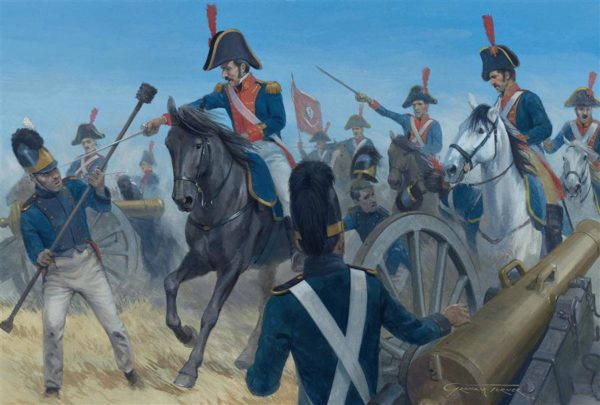
Charge of the Spanish Cavalry courtesy of Osprey Publishing
One appalling postscript to the battle was the grass fires that suddenly took hold on the tinder-dry fields, killing numerous stranded wounded from both sides.
Aftermath
French casualties at Talavera totalled 7,300. The Spaniards lost about 1,200 men; Wellesley’s losses of 5,500 amounted to more than 25% of his entire force.
Although an allied tactical victory, Talavera could be seen as a strategic victory for the French. Wellesley’s army had been bled white and Marshal Soult’s fresh army had swung south, threatening to cut off Wellesley from Portugal. Thinking that the French were weaker than they actually were, Wellesley moved east on August 3rd to block them, having left 1,500 wounded in Spanish care. Surprised by Soult’s numbers, the British commander sent the recently arrived Light Brigade to secure a route out of Spain. With a safe line of retreat, Wellesley considered joining with Cuesta again, when he found out that his Spanish ally had abandoned the British wounded to the French and was proving to be generally uncooperative. Wellesley was further compromised by poorly coordinated Spanish troop movements and broken promises over the supply of equipment and rations. In the spring, the threat of French reinforcement led to Wellesley retiring into Portugal.
For his efforts, after this battle Wellesley was created Viscount Wellington of Talavera.

